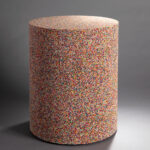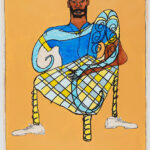“Acquired! Shaping the National Design Collection” on view March 16 through sept. 2, 2024
This March, Cooper Hewitt, Smithsonian Design Museum will present “Acquired! Shaping the National Design Collection,” an exhibition highlighting how the museum acquires new work to shape the collection to better reflect current issues and design’s evolving role in daily interactions. Presented on the second-floor galleries, the exhibition will feature more than 150 works, including objects that represent the museum’s collecting legacy, as well as works brought into the collection since 2017 that demonstrate what it means to be a design museum today.
“What design meant in the late 19th century when Cooper Hewitt’s collection was started is not what design means now. That’s why our collection continues to grow and change as new works and ideas that better define our times are added to it,” said Maria Nicanor, director of the museum. “The entirety of the collection, with both historic and new acquisitions interwoven together, allows Cooper Hewitt to tell more nuanced stories about who we are. Sometimes those stories will embrace the past and sometimes they will confront it to help inform our possible futures.”
Built over the course of more than 125 years, the national design collection has over 215,000 works that represent the evolution of people’s relationship with the world around them. The museum’s founders, Eleanor and Sarah Hewitt, established the collection in the late 19th century as a resource for the study of decorative arts. Cooper Hewitt has expanded on its founders’ original goal to create a platform that is more expansive and better represents previously unexplored areas.
Today, the collection is organized in five curatorial departments, Drawings, Prints and Graphic Design; Product Design and Decorative Arts; Wallcoverings; Textiles; and, most recently, Digital. New acquisitions showcase aesthetic values and mastery of technique, but also reflect the importance of socially responsible practices, racial and social justice, and the impact of the digital era and the climate crisis in people’s lives.
The exhibition begins with a juxtaposition of an ancient Egyptian lotus-shaped cup and the original coronavirus model—among the oldest and newest acquisitions in the collection—both of which are symbols of their time and share a story about how people understand the world around them.
Highlights of the work on view include:
- A projection of Watercolor Maps (2012–2015), the first acquisition of a live website into the collection. Visitors will be able to zoom in on particular cities across the world through this web-based, open-source mapping tool designed by Stamen Design that displays OpenStreetMap’s data with the hand-hewn textures of watercolor paint.
- A series of posters by Jésus Ruiz Durand, created between 1969 and 1972, which are focused on the agrarian reform movement in Peru. These posters created an extraordinarily colorful and hopeful visual campaign that looked to op art (optical art) and pop art for inspiration.
- Faith Ringgold’s 1971 Black feminist poster that adapts the patterning of Kuba textiles from the Democratic Republic of Congo. Ringgold presents a puzzle of words, WOMAN/FREE/YOUR/SELF, each contained within a triangle that individually resonates as a shout and all together becomes a call to action.
- Jay Sae Jung Oh’s Savage Chair (2021), composed of found household objects and discarded everyday items that she has meticulously bound together and laboriously hand-wrapped in leather cord.
- Fernando Mastrangelo’s Rainbow Sprinkle Drum Stool (2017), which uses multi-color sugar sprinkles to create a dynamic static effect while offering a commentary on excess and indulgence in contemporary society.
- Nick Cave’s design for the wallcovering “Wire” (2022), which was digitally printed using matte ink on a metallic Mylar ground to create the effect of a furry surface.
- A 1947 Floor Lamp by Greta Magnusson Grossman, who was pivotal in shaping the visual vocabulary of California midcentury modern design.
- Textile, Van Gogh (designed late 1950s), by Trinidadian artist and designer, Althea McNish, who achieved international recognition in the 1950s and onward for her colorful furnishing and fashion fabrics that often depicted the tropical landscape of her homeland.
- “Girls” (1972) by Alexander Girard, which was designed as part of the Environmental Enrichment Panels series, which were intended to create a more playful and cheerful workspace.
- Charles Reilly’s 2019 digital video, “Choreography of Life,” exemplifies his multidisciplinary creativity as a visual artist and molecular biophysicist. His work uses the design process of creating molecular dynamic simulations to investigate and explore.
circa 1100 BCE
Maker unidentified
Colored faience (ceramic frit)
Cooper Hewitt, Smithsonian Design Museum
Museum purchase through gift of Eleanor and Sarah Hewitt, 1960-29-1
Image © Smithsonian Institution
2020
Designed by Alissa Eckert (American, born 1980) and Dan Higgins (American, born 1969) for Centers for Disease Control and Prevention (CDC) (Atlanta, Georgia, USA)
3D-printed nylon
Courtesy of the Centers for Disease Control and Prevention
2017
Designed and made by Fernando Mastrangelo (American, born 1978)
Sugar sprinkles, resin
Cooper Hewitt, Smithsonian Design Museum
Gift of Fernando Mastrangelo, 2018-24-1
Photo by Matt Flynn © Smithsonian Institution
circa 1974
Designed by Donald M. Genaro (American, born 1932), Office of Henry Dreyfuss Associates
Manufactured by Western Electric Manufacturing Company (New York, New York, USA) (housing) and Bell System Division, AT&T (Parsippany, New Jersey, USA) (works)
Thermoplastic, electronic components
Cooper Hewitt, Smithsonian Design Museum
Gift of Donald M. Genaro, 2018‑40‑1
Photo by Matt Flynn © Smithsonian Institution
Designed late 1950s; printed early 1960s
Designed by Althea McNish (British, born Trinidad, 1924–2020) Manufactured by Hull Traders, Ltd. (UK)
Screen-printed cotton plain weave
Cooper Hewitt, Smithsonian Design Museum
Museum purchase from General Acquisitions Endowment Fund, 2021-1-2
Photo by Matt Flynn © Smithsonian Institution
2012–15
Designed by Eric Rodenbeck (American, born 1970), Zachary Watson (American, 1985–2014), Geraldine Sarmiento (American, born 1972), Nathaniel Kelso (American, born 1980), Michal Migurski (Polish, born 1977), and George Oates (Australian, born 1973) of Stamen Design (San Francisco, California, USA)
Software: Source code, computer generated images
Cooper Hewitt, Smithsonian Design Museum
Gift of Stamen Design in honor of Zachary Watson, 2021-5-1/3
2021
Designed by Sheila Bridges (American, born 1964)
Manufactured by Sheila Bridges Home
Printed by twenty2 wallpaper (Bantam, Connecticut, USA)
Digital print on paper
Cooper Hewitt, Smithsonian Design Museum
Gift of twenty2 wallpaper, 2021-22-1
Photo by Matt Flynn © Smithsonian Institution
1970
Edgardo Giménez (Argentinian, born 1942)
Screenprint on paper
Cooper Hewitt, Smithsonian Design Museum
Gift of the Institute for Studies on Latin American Art (ISLAA), 2021-29-16
Photo by Matt Flynn © Smithsonian Institution
2019
Charles Reilly (New Zealander, born 1983), Wyss Institute for Biologically Inspired Engineering (Boston, Massachusetts, USA)
Video, color and sound
Duration: 03:27 minutes
Cooper Hewitt, Smithsonian Design Museum
Gift of Charles Reilly, 2021-42-2-1
2022
Tschabalala Self (American, born 1990)
Colored pencil, acrylic paint, gouache, charcoal, graphite on archival inkjet print
Cooper Hewitt, Smithsonian Design Museum
Museum purchase through the American Women’s History Initiative Acquisitions Pool, administered by the Smithsonian Women’s History Initiative, 2022-23-1
Photo by Matt Flynn © Smithsonian Institution
2021
New York, New York, USA
Designed by Tschabalala Self (American, born 1990)
Fabrics hand-dyed by Montgomery Harris, Isa Rodrigues (Portuguese, born 1985)
Powder-coated steel; custom fabric, Dacron
Cooper Hewitt, Smithsonian Design Museum
Museum purchase through the American Women’s History Initiative Acquisitions Pool, administered by the Smithsonian Women’s History Initiative, 2022-23-2-a,b
Photo by Matt Flynn © Smithsonian Institution
1972
Designed by Alexander Hayden Girard (American, 1907–1993)
Manufactured by Herman Miller Furniture Company (Zeeland, Michigan, USA)
Screen-printed cotton plain weave
Cooper Hewitt, Smithsonian Design Museum
Gift of Virginia Bayer, 2023-15-1
Photo by Matt Flynn © Smithsonian Institution
1968–73
Jesús Ruiz Durand (Peruvian, born 1940)
Offset lithograph on paper
Cooper Hewitt, Smithsonian Design Museum
Museum purchase from General Acquisitions Endowment Fund, 2023-17-5
2022
Designed by Nick Cave (American, born 1959)
Manufactured by Knoll Textiles (New York, New York, USA)
Nonphthalate vinyl, polyester metallic Mylar
Cooper Hewitt, Smithsonian Design Museum
Gift of Knoll, 2024-3-5
Photo by Matt Flynn © Smithsonian Institution
2004
Designed by Tobias Wong, (Canadian, 1974–2010); Collaborator: CITIZEN:Citizen
Produced in New York, New York, USA
Ballistic nylon (Kevlar®), velvet, platinum
Cooper Hewitt, Smithsonian Design Museum
The Tobias Wong Collection, Gift of Phyllis Chan and Gordon Wong, 2024-4-1
Photo by Matt Flynn © Smithsonian Institution
2020
Designed by Eino Korkala (Finnish, born 1985) and Daniel Coull (South African, born 1990) for Helsingin Sanomat (Helsinki, Finland) and TBWA/Helsinki (Helsinki, Finland)
Digital typeface
Cooper Hewitt, Smithsonian Design Museum
File in public domain, collected by Cooper Hewitt in collaboration with the designers, 2021-30-1
Mid-18th century
Manufactured by Meissen Porcelain Manufactory (Meissen, Germany)
Hard-paste porcelain, vitreous enamel, gold
Cooper Hewitt, Smithsonian Design Museum
Gift of Mrs. Edward Luckemeyer, 1912-13-16-a,b
Photo by Matt Flynn © Smithsonian Institution
1895
Designed by Beggarstaffs (British, active 1893–1899): William Nicholson (British, 1872–1949); James Pryde (British, 1866–1941)
Printed by Artistic Supply Co. Ltd. (England, UK)
Printed by Stafford and Company Limited (Netherfield, Nottingham, England, UK)
Published by Harper’s Weekly
Lithograph on paper
Cooper Hewitt, Smithsonian Design Museum
Gift of Merrill C. Berman and Dalia S. Berman, 2019-15-1
Photo by Matt Flynn © Smithsonian Institution
1971
Faith Ringgold (American, born 1930)
Offset lithograph on paper
Cooper Hewitt, Smithsonian Design Museum
Museum purchase through the American Women’s History Initiative Acquisitions Pool, administered by the Smithsonian American Women’s History Initiative, and from the General Acquisitions Endowment Fund, 2022-20-1
Photo by Matt Flynn © Smithsonian Institution
circa 1947
Designed by Greta Magnusson Grossman (American, born Sweden, 1906–1999)
Manufactured by Ralph O. Smith Co. (Burbank, California, USA)
Steel, aluminum, paint
Cooper Hewitt, Smithsonian Design Museum
Museum purchase through the American Women’s History Initiative Acquisitions Pool, administered by the Smithsonian Women’s History Initiative and from General Acquisitions Endowment Fund, 2020‑14‑3
Photo by Matt Flynn © Smithsonian Institution
SUPPORT
Generous support for “Acquired! Shaping the National Design Collection” is provided by Cooper Hewitt’s Collections Committee and by the Lily Auchincloss Foundation.
ACKNOWLEDGMENTS
The exhibition is organized by Maria Nicanor, director; Matilda McQuaid, acting director of curatorial; Christina De León, acting deputy director of curatorial and associate curator of Latino design; Cynthia Trope, associate curator, Product Design and Decorative Arts; and Sophia Gebara, curatorial assistant.
Exhibition design by Field Guide Architecture and Design with Castro Watson. Exhibition graphic design by Kelly Sung.
ABOUT COOPER HEWITT, SMITHSONIAN DESIGN MUSEUM
Cooper Hewitt is America’s design museum. Inclusive, innovative and experimental, the museum’s dynamic exhibitions, education programs, master’s program, publications and online resources inspire, educate and empower people through design. An integral part of the Smithsonian Institution—the world’s largest museum, education and research complex—Cooper Hewitt is located on New York City’s Museum Mile in the landmarked Carnegie Mansion. Steward of one of the world’s most diverse and comprehensive design collections—over 215,000 objects that range from an ancient Egyptian faience cup dating to about 1100 BC to contemporary 3D-printed objects and digital code—Cooper Hewitt welcomes everyone to discover the importance of design and its power to change the world.
For more information, visit www.cooperhewitt.org or follow @cooperhewitt on Instagram, Facebook and YouTube.




















